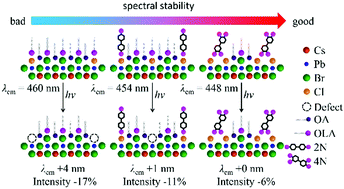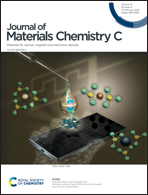Surface modification strategy based on molecular engineering of an organic cation toward spectrally stable deep-blue emission perovskites†
Abstract
All-inorganic perovskites (AIP) with three primary color emission are all-important for AIP application in many fields. However, poor spectral stability seriously hinders the development of blue-emission AIP. Here, we achieved stable deep-blue emission by modifying CsPbBr3−xClx with organic cations. The two ligands improve the luminescence properties of CsPbBr3−xClx by reducing surface defects and increasing exciton binding energy. The electrostatic interaction between –NH3+ and Cl− can inhibit the phase separation of CsPbBr3−xClx and improve the spectral stability of CsPbBr3−xClx. Moreover, the modification effect of the ligand is more obviously increased with the stronger positive charge of –NH3+ and the greater amount of –NH3+. Notably, the deep-blue emission (λem < 450 nm) CsPbBr2Cl modified with 4,4′-biphenyltetramine hydrochloride shows strong spectral stability under continuous ultraviolet light. This work suggests the constructive effect of introducing extra –NH3+ in surface ligands and provides a new model and idea for improving the spectral stability of CsPbBr3−xClx with multidentate ligands.



 Please wait while we load your content...
Please wait while we load your content...